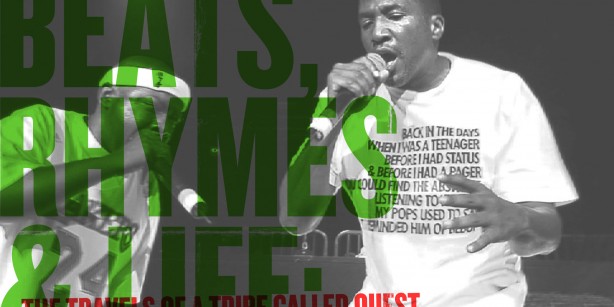 Music
Music
HOT DOCS REVIEW: Beats, Rhymes & Life: The Travels of A Tribe Called Quest
by Tyler Munro
May 8, 2011
Q-Tip raps on one side of the stage while a contemplative Phife sits his opposite—the camera focuses on Phife, intentionally or not drawing attention to his Seattle Supersonics shirt, a moment of clarity for fans of both hip-hop and basketball culture and a metaphor that's doubly effective because of it. As director and long-time NBA basketball super-fan Michael Rapaport can tell you, 2008 is the year the Seattle Supersonics basketball team was controversially relocated—stolen according to some—to Oklahoma City, the same time in which in-fighting, egos and illness threatened not just the legacy of hip-hop royalty, but the friendship of brothers bonded together since infancy. If intentional, the opening minutes of Beats, Rhymes & Life are a remarkable culture-clash of complimentary falls from grace. If not, they're still pretty moving.
Q-Tip raps on one side of the stage while a contemplative Phife sits his opposite—the camera focuses on Phife, intentionally or not drawing attention to his Seattle Supersonics shirt, a moment of clarity for fans of both hip-hop and basketball culture and a metaphor that’s doubly effective because of it. As director and long-time NBA basketball super-fan Michael Rapaport can tell you, 2008 is the year the Seattle Supersonics basketball team was controversially relocated—stolen according to some—to Oklahoma City, the same time in which in-fighting, egos and illness threatened not just the legacy of hip-hop royalty, but the friendship of brothers bonded together since infancy. If intentional, the opening minutes of Beats, Rhymes & Life are a remarkable culture-clash of complimentary falls from grace. If not, they’re still pretty moving.
Beats, Rhymes & Life takes its name from A Tribe Called Quest’s fourth album, their ill received penultimate release that is, for many, the hump that broke the camel’s back. It’s a fitting title for a film with a similarly disconnected pace, but far from an apt point of quality comparison. As divided as Beats, Rhymes & Life may be structured, organized in three acts of increasingly disheartening tales of ego and miscommunication with an optimistic, though far from idealistic, epilogue, the documentary serves in its entirety as a reminder of the spirit of hip-hop as it was and will hopefully soon be again.
While much of the opening third of the documentary focuses on the roots of New York hip-hop and how they influenced A Tribe Called Quest’s early years, the doc’s main focus is the story of two friends, Kamaal (Q-Tip) and Malik (Phife Dawg) and, more specifically, how such a friendship can make and later break one of hip-hop’s most renowned acts.
Sitting in a makeshift bedroom studio, Q-Tip tells the camera of the time he came across the Lonnie Smith song (Spinning Wheel) that would give drums to Tribe’s 1991 classic “Can I Kick It?” Tip recreates the loop before the camera.
“I was pissin’ my pants,” he tells director Michael Rapaport of the first time he heard the song’s drums.
Chuckling, giggling and reminiscing, these are the moments that best define the documentary; moments of character and charisma, not ego and drama; moments that are few and far between as the film plays on, but ones that bring it all together in the end.
The easiest way to summarize Beats, Rhymes & Life is in referring to how it explains the links between hip-hop and bebop. The viewer is told about how both were formed around improvisation; how bebop searched for melody and musicality while hip-hop looked for lyricism—a fitting metaphor for a film during which the viewer will have a hard time not headbobbing to bevy of classic hip-hop tracks while struggling to separate the music from the tumult of A Tribe Called Quest’s increasing tension. Beats, Rhymes & Life is at its most enjoyable when it separates the music from the message.
While it’s their fourth (and first, to a point) album that gives the documentary its title, their fifth is what gives it its spirited closure. Phife’s diabetes is what heightens tension between friends, but it’s also what reunites them. Through it all, the documentary leaves the viewer hoping for A Tribe Called Quest’s future, ending in noting that they’ve still got one album left on their original recording contract. It’s a point of optimism, not realism, but a welcome change for a group whose last few years have been covered in disappointment. And if there’s anything to be taken from a viewing of Beats, Rhymes and Life, it’s the urgency with which all who were lucky enough to see it reached for their headphones as they left the theatre. As A Tribe Called Quest seemed almost reinvigorated at the end of the film, so is the viewer’s love of their music. In the end, that’s probably enough to deem it a success.
Tags: Music, a tribe called quest, hot docs





